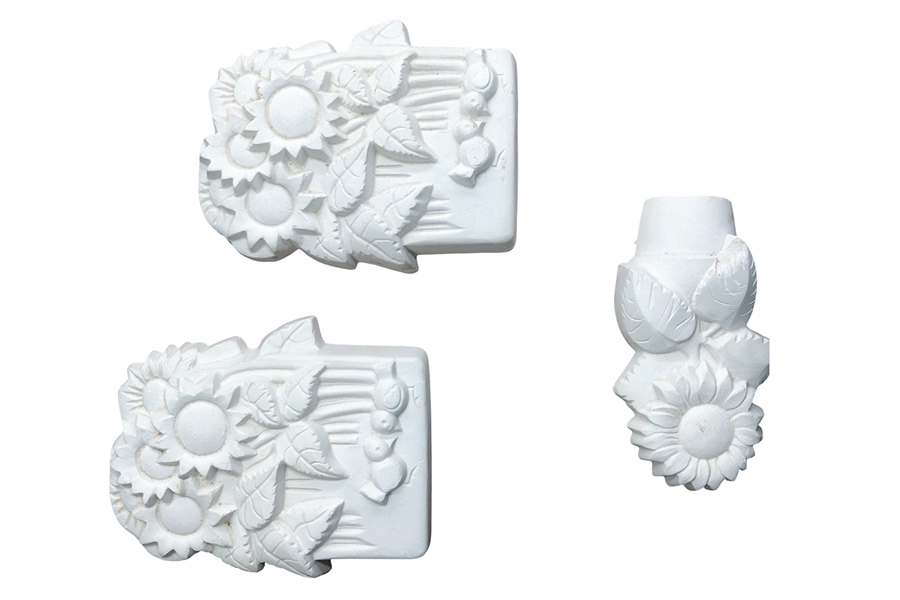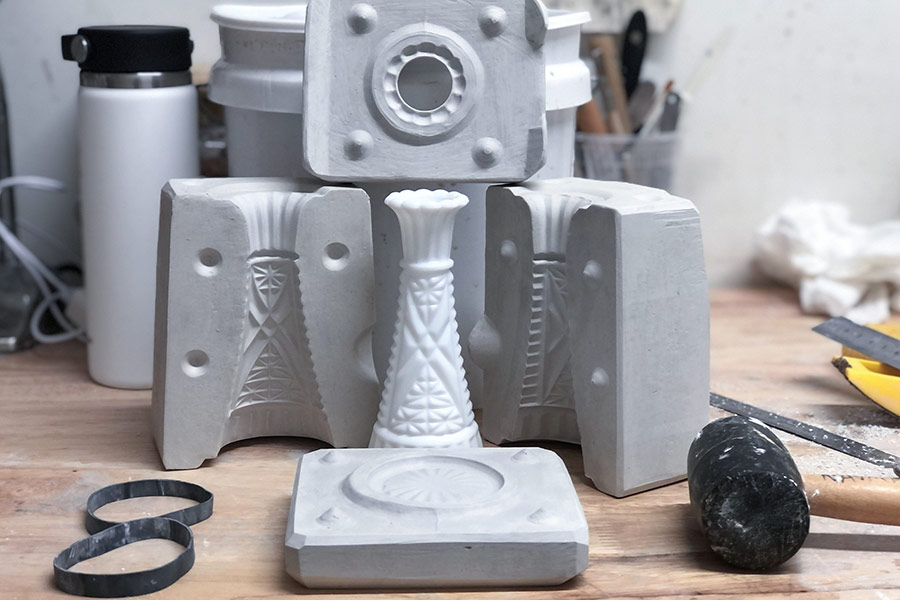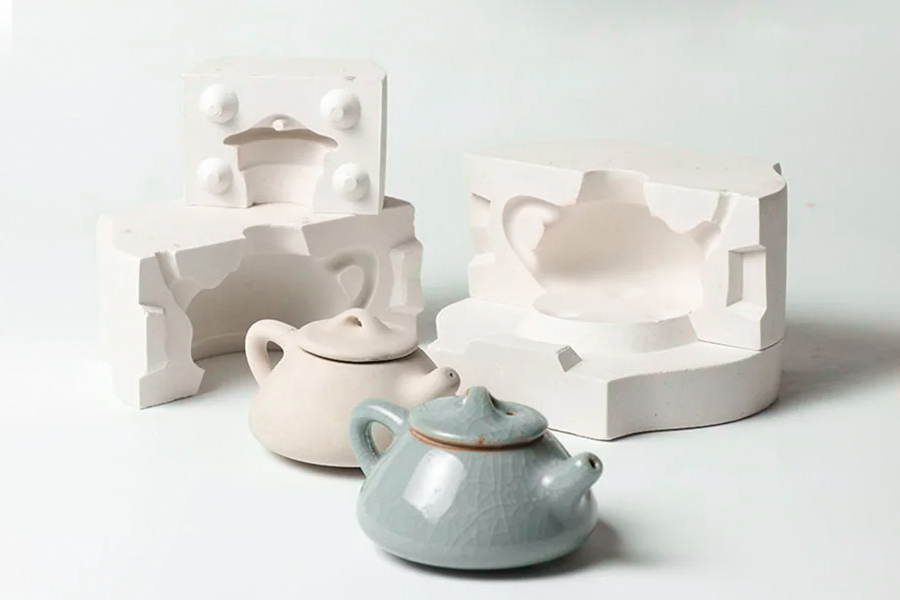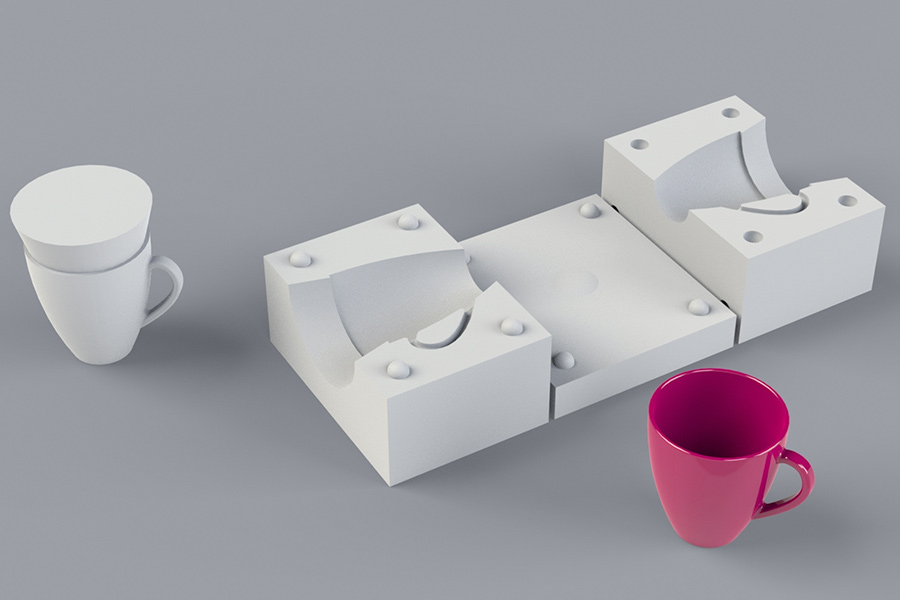Plaster molds are three-dimensional replicas formed by mixing plaster powder (calcium sulfate hemihydrate) with water and solidifying. They are widely used in architecture, medicine, art, industrial design and other fields. With its low cost, easy operation and high molding precision, plaster models are still an important tool for making prototypes, replicating details and teaching demonstrations. Whether it is precision casting of dental restorations or rapid prototyping of architectural decorative components, plaster molds can provide reliable solutions. This article will deeply analyze the production principles, technical advantages, application scenarios and modern improvement directions of plaster molds to help you fully understand this classic and practical molding technology.
What Constitutes the Core Definition of a Plaster Mold?
The Plaster mold is a three-dimensional solid structure made of α-type semi-hydrated Plaster (ASTM C28 standard) by accurately mixing the water-to-cement ratio (0.6-0.8:1). Its technical essence lies in the perfect combination of controllable crystallization and solidification mechanism and microporous structure design. This traditional process has been developed into an industrial-grade solution with high-precision molding and controllable mechanical properties through the optimization of modern materials science.
Scientific definition of plaster mold
Material system characteristics
- Core component: α-type hemihydrate gypsum (CaSO₄·½H₂O)
- Proportion specification: strictly controlled within the water-to-cement ratio range of 0.6-0.8:1
- Mechanical indicators: compressive strength after curing > 20MPa (more than 3 times that of ordinary plaster)
- Structural parameters: porosity 15-30% (the key to balancing strength and detail restoration)
Molding reaction principle
The formation of plaster model is essentially a process of building a hydration crystal network:
- CaSO₄·½H₂O + 1.5H₂O → CaSO₄·2H₂O + heat release
The calcium sulfate dihydrate crystals (grain size 5-50μm) generated by the reaction form a rigid skeleton through a three-dimensional interlocking structure, and the micropore system gives the model unique surface adsorption properties.

How Does Casting Plaster Differ from Plaster of Paris?
Casting Plaster and Plaster of Paris are often confused in industrial applications of plaster-based materials, and LS reveals the essential differences between the two through laboratory-grade data comparisons based on the ASTM C59 standard to help you accurately select the right material for your project.
1.Comparison of material preparation process differences
(1)Calcination process parameters
| Parameters | Casting Plaster (α type) | Plaster of Paris (β type) |
|---|---|---|
| Calcination temperature range | 150-170℃ | 120-150℃ |
| Calcination duration | 8-12 hours | 4-6 hours |
| Raw material plaster form | Block natural plaster | Powdered plaster |
(2)Crystal structure characteristics
- Casting plaster : closed-cell α crystals (particle size 5-20μm)
- Plaster of Paris: open-cell β crystals (particle size 30-80μm)
2.Comparison of key performance indicators
(1)Solidification characteristics
| Performance indicators | Casting Plaster | Plaster of Paris |
|---|---|---|
| Initial setting time | 20-30 minutes | 8-12 minutes |
| Final setting time | 45-60 minutes | 15-20 minutes |
| Operation window | 30 minutes Controllable period | <5 minutes |
2.Mechanical strength data
Compressive strength (dry state)
▶ Casting plaster: 28-32MPa
▶ Plaster of Paris: 8-12MPa
Flexural strength
▶ Casting plaster: 6-8MPa
▶ Plaster of Paris: 2-3MPa
3.The mechanism of the influence of microstructure on performance
(1)Porosity difference
- Casting plaster: 15-25% closed-cell structure
- Plaster of Paris: 35-45% connected pores
(2)Hydration reaction path
Casting plaster: CaSO₄·½H₂O → directional crystallization → CaSO₄·2H₂O (dense structure)
Plaster of Paris: CaSO₄·½H₂O → disordered crystallization → CaSO₄·2H₂O (porous structure)
4.Guidelines for Selection of Industrial Application Scenarios
(1) Scenarios that give priority to casting plaster
- Precision Casting (Jewelry/Dental)
- High-precision mold (<0.1mm tolerance)
- Functional prototyping (load-bearing structures)
(2)Scenes suitable for plaster of paris
- Architectural decorative components
- Artistic sculpture prototypes
- Disposable packaging molds
5.Cost-effectiveness analysis (based on an annual production of 100,000 pieces)
| Cost items | Casting plaster solution | Plaster of Paris solution |
|---|---|---|
| Material cost per piece | $0.8-1.2 | $0.3-0.5 |
| Equipment investment | $50,000+ | $10,000 |
| Scrap rate | <5% | 15-20% |
| Comprehensive cost-effectiveness | High precision preferred | Low-cost temporary solution |
Although the investment in equipment and material costs for casting plaster solutions is high, the scrap rate is low and the precision is high, making it suitable for production with strict quality requirements; on the other hand, the investment in equipment and material costs for calcined plaster solutions is low, but the scrap rate is higher, making it more suitable for temporary production needs that are cost-sensitive and not demanding on precision. The engineering team deeply understands the essential differences between the two materials and prioritizes small batch process verification tests based on actual working conditions, which can effectively reduce trial and error costs by more than 30%.

How to Evaluate Quality Standards for Plaster Molds?
The quality of plaster molds directly determines the accuracy, pass rate and cost-effectiveness of the final product. According to international standards such as ASTM and ISO, industrial-grade plaster molds need to focus on evaluating the following performance indicators. This section combines test methods with practical optimization techniques to help you systematically establish a quality control system!
Appearance and Precision
The surface of the mold should be smooth and free of bubbles, with clear patterns and no deformation or cracks.
The uniformity of thickness (for example, the thickness of the plaster line should be ≥8mm) directly affects the durability of the mold and the quality of the finished product.
Strength and durability
High-quality plaster molds should have high compressive strength (such as the compressive strength of α low expansion plaster reaching 30-32 mpa) and low expansion coefficient (≤0.02%) to ensure that they can maintain accuracy after multiple uses.
Cost and Efficiency
The production cycle of plaster molds is short (skilled workers can complete it in half an hour), and the cost is only 1/5 of that of silicone or metal molds, making it suitable for medium and small batch production.

Where Are Plaster Molds Most Effectively Utilized in Industry?
Plaster molds occupy an important position in the industrial field due to their high precision, low cost and rapid prototyping. Especially in the following three scenarios, plaster molds show irreplaceable technical value. LS will combine ISO standards with real cases to analyze its core advantages and application details!
1.Precision casting: “replication artifact” for complex artworks and metal parts
- Application scenarios: aluminum alloy/copper alloy artworks, precision mechanical parts casting.
Technical highlights:
Surface accuracy:
- Plaster molds can achieve a surface roughness of Ra 3.2μm (in line with ISO 1302 standard), meeting the needs of artwork texture reproduction.
- Detail restoration ability is better than silicone molds, especially suitable for engraving patterns and hollow structures.
Process adaptability:
Adopting investment casting method: plaster wrapped wax mold → high temperature dewaxing → injection of molten metal to achieve thin-walled (0.5mm) complex parts molding.
Heat resistance: Special casting gypsum can withstand short-term high temperature of 1200℃ (such as aluminum alloy pouring temperature of about 700℃).
Case:
A high-end home brand uses plaster molds to cast bronze relief decorative parts, with a single mold output of 200+ pieces, reducing costs by 40%.
2.Medical modeling: the “precision foundation” of dental restorations
- Application scenarios: crowns, implant guides, orthodontic model production.
- Technical highlights:
- Dimensional accuracy:
Meets ISO 6873 Class IV standard, dimensional error ±0.1mm, matching the stringent requirements of oral restorations.
High expansion rate control (<0.15%) ensures consistency between the model and the scanned data.
Biological compatibility:
Medical plaster is non-toxic and non-irritating and can directly contact oral impression materials (such as silicone rubber).
Fast curing (final setting ≤25 minutes) improves diagnosis and treatment efficiency.
Case:
A chain dental institution uses Class IV plaster molds to make implant guides, and the success rate of surgery has increased to 98%.
3.Ceramic mass production: the “efficiency engine” of the thousand-year-old porcelain capital
Application scenarios: mass production of daily ceramics, handicrafts, and industrial ceramics.
Technical highlights:
Durability:
Under high-pressure grouting process, the life of plaster molds is >5,000 times (mass production standard of Jingdezhen blue and white porcelain).
Adding reinforcing fibers (such as glass fibers) increases the flexural strength by 30%.
Cost control:
The cost of a single mold is only 1/10 of that of a metal mold, which is suitable for small-batch customized production.
The water absorption rate is controllable (18-22%), shortening the drying time of the blank.
Case:
A ceramic company uses plaster molds to mass-produce special-shaped tea sets, with a daily output of more than 3,000 pieces and a yield rate of 95%.
3 core advantages of gypsum molds
Economical and efficient:
Low material cost (about 5-10 yuan per kilogram of gypsum powder), and the development cycle is 70% shorter than that of metal molds.
Environmentally friendly and sustainable:
Waste gypsum can be recycled and crushed and reused for low-precision model making.
Cross-industry compatibility:
By adjusting the water-powder ratio and additives (such as retarders), it can adapt to the needs of multiple fields such as casting, medical, and ceramics.
From artistic casting to medical restoration, from ceramic mass production to industrial parts, plaster molds have become the “hidden champion” of manufacturing in many fields with their triple advantages of precision, cost and efficiency. Mastering the material properties and process parameters can maximize its industrial value!

Why Choose Plaster Molds Over Silicone or 3D Printed Molds?
In industrial manufacturing, the selection of mold materials directly affects the cost, efficiency and quality of the finished products. plaster molds, with their unique advantages, outperform silicone molds and 3D printed molds in some scenarios. Their irreplaceability can be demonstrated from four dimensions.
First, it has a significant cost advantage
Unit area cost: plaster mold is about 50 yuan per square meter, silicone mold is about 250 yuan per square meter, and 3D printing mold is about 800 yuan per square meter. A certain automobile company developed a door interior handboard. The cost of the plaster mold was 12,000 yuan, which was 80% cheaper than the silicone solution. In addition, the plaster mold equipment is simple, only requiring a vacuum mixer, and the modification cost is low, only 1/10 of that of the silicone mold.
Second, the precision performance is excellent
Surface roughness: The Ra value of plaster molds is 1.6-3.2μm, suitable for aerospace castings. The Ra value of the silicone mold is 0.8-1.6μm, and it is used for medical devices. The Ra value of the 3D printed mold is 6.3-12.5μm, which is used for the verification of non-appearance parts. plaster molds can present a texture of 10μm, which is superior to the elastic deformation of silicone and the step effect of 3D printing. In the case of a certain airline company, the Ra value of the finished plaster mold was 1.6μm. 3D printing required additional polishing, which took three times as long.
Third, the efficiency is significantly ahead.
Mold production cycle: plaster mold prototype 1 hour, manufacturing 4 hours, modification 0.5 hours; Silicone molds correspond to 2h, 24h and 6h. The 3D printing mold takes 0.5 hours for scanning and 8 hours for printing. Any modification requires reprinting for 8 hours. The plaster mold is easy to modify and can be filled and repaired within 30 minutes.
Fourth, wide adaptability
Material compatibility: plaster molds are suitable for metals, ceramics, etc., and can withstand high temperatures up to 1200℃. Silicone molds are suitable for resins, etc., and can withstand 200℃. 3D printed molds are suitable for resins, etc., and can withstand temperatures ranging from 80 to 150 degrees Celsius. In terms of process, the plaster mold can withstand a pressure of 20MPa and is suitable for 700℃ aluminum alloy casting. Silicone is prone to deformation, and 3D printing resin will carbonize.
Fifth, win-win between environmental protection and the economy.
Waste treatment: plaster molds can be recycled. Silica gel is difficult to degrade and toxic when burned. The recovery rate of 3D printing materials is less than 30%. For small-batch orders (less than 100 pieces), the cost of plaster molds is 60% lower than that of 3D printing. For orders of more than 500 pieces, although the amortized cost of silicone is lower, the delivery of plaster molds is faster.
In conclusion, plaster molds have significant advantages in terms of cost, precision, iteration speed, and high-temperature resistance, making them suitable for small-batch trial production, high-precision casting, and frequent design modifications.

Summary
The plaster mold is a multifunctional tool made of α-hemihydrate plaster through precise proportioning and process molding. It has the core advantages of high precision, low cost and rapid iteration. Its unique microporous structure (air permeability > 5×10⁻¹¹ m²) and controllable expansion rate (<0.15%) make it irreplaceable in precision casting, dental modeling and ceramic mass production, especially suitable for small batches, high complexity and rapid verification of industrial scenarios. Compared with silicone and 3D printing molds, plaster molds have become an efficiency engine for cross-domain manufacturing with an extreme cost-effectiveness of 80% lower unit cost and surface accuracy of Ra 1.6μm. At the same time, it realizes an environmentally friendly closed loop through its recyclable characteristics. It is a model of the perfect integration of traditional craftsmanship and industrialization needs.
📞 Phone: +86 185 6675 9667
📧 Email: info@longshengmfg.com
🌐 Website: https://lsrpf.com/
Disclaimer
The content of this page is for informational purposes only.LS SeriesNo representations or warranties of any kind, express or implied, are made as to the accuracy,completeness or validity of the information. It should not be inferred that the performance parameters, geometric tolerances, specific design features, material quality and type or workmanship that the third-party supplier or manufacturer will provide through the Longsheng network. This is the responsibility of the buyerAsk for a quote for partsto determine the specific requirements for these parts.please Contact us Learn more information.
LS Team
LS is an industry-leading companyFocus on custom manufacturing solutions. With over 20 years of experience serving more than 5,000 customers, we focus on high precisionCNC machining,Sheet metal fabrication,3D printing,Injection molding,metal stamping,and other one-stop manufacturing services.Our factory is equipped with more than 100 state-of-the-art 5-axis machining centers and is ISO 9001:2015 certified. We provide fast,efficient and high-quality manufacturing solutions to customers in more than 150 countries around the world. Whether it’s low-volume production or mass customization,we can meet your needs with the fastest delivery within 24 hours. chooseLS TechnologyIt means choosing efficiency, quality and professionalism.
To learn more, please visit our website:www.lsrpf.com

FAQs
1.What is a plaster mold?
Plaster molds are temporary or semi-permanent molding tools made of α-hemihydrate gypsum through vacuum mixing, precision infusion and curing processes. They are widely used in precision casting, dental restoration, ceramic mass production and other fields. Their core advantages lie in high detail reproducibility (surface roughness Ra 1.6-3.2μm), low cost (the unit area cost is only 1/5 of that of silicone molds) and fast iteration capability (local repairs can be completed in 30 minutes).
2.What type of plaster is used for plaster molds?
Industrial-grade plaster molds must use high-purity α-hemihydrate gypsum and comply with ISO 6873 (dental), ASTM C472 (casting) and other standards. Fiber reinforcement or foaming agent is added according to the scene. For example, dental models use Class IV superhard gypsum (compressive strength ≥ 50MPa), and ceramic grouting molds require a high air permeability formula (>5×10⁻¹¹ m²).
3.What are the advantages of plaster molds over 3D printed molds?
Plaster molds have advantages in surface accuracy (Ra 1.6μm vs 6.3μm for 3D printing), high temperature resistance (1200℃ short-term tolerance vs 80℃ limit for 3D resin molds) and cost (unit cost is 80% lower), and are especially suitable for aluminum alloy casting, medical models and other scenes that require high precision and heat resistance, while 3D printing is more suitable for rapid prototype verification.
4.Which industrial fields are plaster molds suitable for?
Its core applications include: ① Precision casting (such as aerospace aluminum alloy parts, surface roughness Ra 3.2μm); ② Dental medicine (ISO 6873 Class IV model, dimensional accuracy ±0.1mm); ③ Ceramic mass production (Jingdezhen standard mold life > 5000 times); ④ Art reproduction (micron-level texture reproduction), covering needs from single-piece customization to medium-sized batch production.







